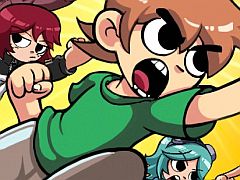Video Gamer is reader-supported. When you buy through links on our site, we may earn an affiliate commission. Prices subject to change. Learn more
The simple three-step guide to developing a crap commercial product is to take a good novel, dilute the basic dialogue into a film script, then take any interesting action and create a game that defiles every square inch of that franchise’s holy ground. It happens. Most big films will get a video game tie-in, anyway. The quintessential example from recent years is 2009’s Watchmen: End is Nigh, the episodic beat-em-up that served as a prequel for the film.
End is Nigh managed to take the thematic heart of the original graphic novel and bin it, creating a game that was based mostly on the bits where Rorschach punched someone’s face. Most of the time you wish that these developers would have someone on their shoulder to whisper “No”. No, guys, don’t cash in on cult favourites – that never works. No, buddy, put down the book. The obvious difference with Scott Pilgrim is that it’s stylistically built for this kind of cross-media manipulation.
Bryan Lee O’Malley’s graphic novel is fuelled by games culture. It’s an action-based comedy with scenes involving loot drops when Scott defeats one of his adversaries. Scott’s band is called Sex Bob-Omb, as a tip-of-the-hat to Super Mario. Even the premise has the structure of a simple arcade brawler, with Scott Pilgrim taking on the role of a slacker Torontonian who must fight the seven evil ex-boyfriends of his love interest, Ramona Flowers.
For a game that’s coming out alongside a film adaptation, Scott Pilgrim doesn’t have the stink lines that typically waft off franchise tie-ins, and that’s largely because there are no actual visual links to the film: what you get instead is an 8-bit throwback to the likes of River City Ransom and Double Dragon. The arcade sensibilities run all the way through, from gameplay right into art and sound design. The music is done by the NYC Chiptune outfit Anamanaguchi, while the graphics have been created by the brilliant animator Paul Robertson, probably best known for creating the extensive 2D music video for indie band Architecture in Helsinki.
The game plays as a traditional side-scroller, letting you progress left to right as you fight anyone you come across. It’s all fairly standard. Enemies will attack you; your job is to defeat them. You get basic light and heavy attacks, along with special moves assigned to the shoulder buttons. You’ll earn new moves as you level up, but basically you simply punch and kick at enemies while damage figures spill out of their head. Up to three other players can join Scott in the brawl, taking on the role of Ramona, Kim Pine and Steven Stills.
The sheer volume of enemies with varying abilities is what makes the game difficult, and inevitably more fun. Even on the easiest setting they’ll come at you from all sides, knocking you down, dog piling on top of you so that you can’t move. Fat men in dinosaur costumes breath fire, forcing you to dodge around them at a distance. Paparazzi from a film set will come at you with cameras, their flash making it impossible to get too close. There are emo mallrats that dash and slide, making them more difficult to fight with fists alone. Enemies are easier to take down when you’re wailing on them with one of the many in-game objects that happen to be lying around: Take a shovel or a traffic pylon and use it to belt someone in the face. If an enemy has passed out during a fight you can use them like a bat against the hordes of others.
But what really makes the game is its relation to the world of Scott Pilgrim. Like the novel, the game is pure Canadiana. Defeat enemies and they’ll drop Canadian pocket change. At one point you’ll walk past the Toronto video store where Scott’s band-mate works; walk inside and you get yet another casual reference to the novel – a reference to the video late fees Pilgrim has racked up.
You’ll fight enemies and see characters from the book standing on the pavement, looking on as you throttle the reams of boy-enemies. You can punch those familiar faces and they’ll flinch or glare. You can drop into a shop to buy food to boost your health and powers, and pick up some poutine. It’s that onslaught of twee, suburban details that makes the game one of the funniest and most off-kilter brawlers we’ve seen in years.
But even if you cast aside these references, Scott Pilgrim stands out as a strong game in its own right. It’s an impressive little throwback that functions as a love-letter to early games culture, a treat for a nostalgic gamer demographic. It’s so impressive in its dedication that it’s occasionally too traditional, all too straightforward in its walk-right-and-punch style, and yet it’s ultimately this style that makes it stand out from any other game/movie tie-in.

/https://oimg.videogamer.com/images/1dd4/scott_pilgrim_vs_the_world_the_game_6.jpg)